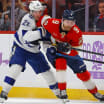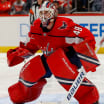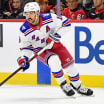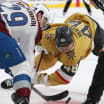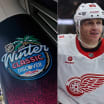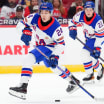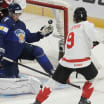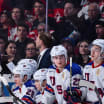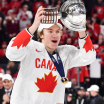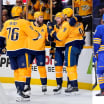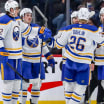SAN JOSE -- Mario Lemieux stood alone on the ice amid the celebration, quietly watching like a proud father as his Pittsburgh Penguins took one last lap with the Stanley Cup. He had hoisted the Cup twice as a player with the Penguins, in 1991 and 1992. It had helped set him apart as one of the greatest players in NHL history.
Now Sidney Crosby and Evgeni Malkin had hoisted the Cup twice as players too, following their 2009 championship with another one after seven years of struggling through injuries, disappointment and doubt.
Crosby, Malkin match Lemieux with second Cup title
Penguins owner hopes 'there's a few more for them'
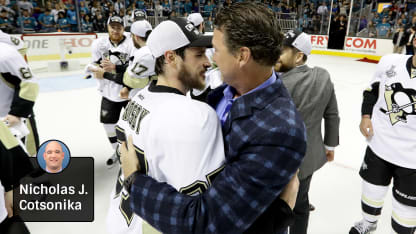
No one would have predicted this a year ago, when the Penguins lost in the first round of the playoffs, or six months ago, when they changed coaches, but here were Crosby and Malkin after clinching with a 3-1 victory against the San Jose Sharks in Game 6 of the Stanley Cup Final at SAP Center on Sunday, on top again, at another level.
"I think it's important for great players like Sid and Malkin to have two Cups," said Lemieux, who won the Cup for the second time as a Penguins owner. "It's so hard to win it year after year, and for them to be able to come through this year and win their second Cup …"
Lemieux didn't finish his sentence, maybe because he felt Crosby and Malkin weren't finished yet.
"Hopefully there's a few more for them," he continued. "They're amazing players."
They are amazing, both winners of the Hart Trophy as the regular season's most valuable player and now both winners of the Conn Smythe Trophy as playoff MVP. Malkin won the Conn Smythe in 2009. Crosby won it this year.
Crosby was a controversial choice, considering he didn't lead his own team in scoring and was minus-2 in the playoffs. He had six goals and 19 points, while Phil Kessel led the Penguins with 10 and 22. But it was Crosby who made it possible for the Penguins to put rookie Conor Sheary on the top line, and it was Crosby who always drew the toughest matchups, leaving softer matchups for the others. Without Crosby and Malkin, Kessel is not on the third line. How many teams have that luxury?
"I think it places him up there with the greats of the game of all time," Penguins coach Mike Sullivan said. "He's that good in my mind. I've said all along here through the course of the playoffs, he's deserving of the Conn Smythe. His numbers don't indicate the impact he had on helping this team win or the impact he had on a game-to-game basis."
Said Penguins general manager Jim Rutherford: "What gets overlooked here is Sid's leadership. He's an all-around player. Everybody's looking to see how many points he's going to get every game, but he brings so much more to our team, and his leadership is phenomenal."
That said, Crosby did not score in his last seven playoff games and had one goal in his last 10. Malkin had two in his last nine. Two of the best players in the world did not dominate the scoresheet, yet one of them won the Conn Smythe and their team won the Cup thanks to a new coach, a new supporting cast and instant chemistry. That's maybe even more amazing.
Rutherford set out to give Crosby and Malkin more help after he took over the Penguins in June 2014, and he overhauled the roster around the core of Crosby, Malkin, forward Chris Kunitz, defenseman Kris Letang and goaltender Marc-Andre Fleury.
The key acquisition: Kessel in July 2015. Critics wondered if Kessel could be part of a championship team when he played for the Boston Bruins and Toronto Maple Leafs, and he was left off the United States roster for the World Cup of Hockey in September. Well, Lemieux called him an "amazing competitor" Sunday night.
"I think Jim Rutherford deserves a lot of the credit, starting with the Phil Kessel trade," Lemieux said. "That was an important piece, as you saw in the playoffs."
Another key move: promoting Sullivan from Wilkes-Barre/Scranton of the American Hockey League on Dec. 12. The Penguins were 15-10-3 at that point. They lost their next four games by combined margin of 15-4. But Sullivan played to the Penguins' strengths of speed and skill.
"We tried to create an identity," Sullivan said. "When we go in and play a team, their coaches have a meeting before the game. What are they saying about the Pittsburgh Penguins? If 29 teams are saying the same thing, then we've created an identity. That's what we tried to do."
Rutherford kept making moves to fit that identity. He traded for defenseman Trevor Daley on Dec. 14, forward Carl Hagelin on Jan. 16 and defenseman Justin Schultz on Feb. 27. He called up Sheary, Tom Kuhnhackl, Matt Murray and Bryan Rust along the way. They had played for Sullivan in the AHL, so they knew what he expected and he knew what they could do.
Not only did the Penguins make the playoffs, they entered the playoffs having won 15 of their last 17 games and discovered the "HBK Line" of Hagelin, center Nick Bonino and Kessel that would make them a matchup nightmare for opponents.
"When you have so much turnover the last couple years like we had, it's not easy to throw a bunch of guys together and develop that chemistry, that trust," Crosby said. "It doesn't happen overnight. When you look at the group, how many new players we brought in, it was pretty special what we were able to do."
The Penguins' chances seemed slim in the Eastern Conference First Round against the New York Rangers. Malkin and defenseman Olli Maatta had missed the end of the regular season with injuries. Fleury, the starting goaltender, was out with a concussion. Murray, the backup, was out with a concussion. But Maatta returned, and Malkin returned, and Murray returned and took over the net, and the Penguins defeated the Rangers, the team that had eliminated them last season, in five games.
They went on to defeat the Washington Capitals, the winners of the Presidents' Trophy as the NHL's top regular-season team, in six. They went on to defeat the Tampa Bay Lightning, the Stanley Cup runner-up last season, in seven after facing a 3-2 series deficit, even though they lost Daley to injury during the series. Who scored both goals in their 2-1 victory in Game 7? Not Crosby. Not Malkin. Not Kessel. It was Rust, a rookie.
Even so, few picked the Penguins to beat the Sharks in the Stanley Cup Final. The Sharks were supposed to be bigger, tougher, harder, the stereotypical superior team from the Western Conference. They were supposed to pin the Penguins in their zone, grind them and wear them down.
But the Penguins set the tone by flying past them in the first period of Game 1, and they proved to be the superior team throughout the series offensively and defensively. Frankly, the Sharks were lucky the series went six games; San Jose won Game 3 in overtime and Game 5 thanks to stellar goaltending by Martin Jones.
"This is maybe the smartest hockey team I've ever seen," Penguins defenseman Ben Lovejoy said. "Everybody talks about our speed, but we bought in. We bought in for a reason. We were at wits' end. We'd done everything we could to solve our problems the first half of the year. We weren't able to get there. Sully came in with an idea, with a plan, and we had no choice. From our first line to our third D pairing, everybody bought in, and that was the reason we were able to turn this around."
It was hard enough to win the Cup twice when Lemieux did it. It is harder now in this era of the salary cap and parity, but possible with a strong core, savvy management, smart coaching and cohesive performance. The Penguins are one of three teams to win the Cup multiple times since the cap was introduced in 2005-06, joining the Chicago Blackhawks (2010, 2013, 2015) and Los Angeles Kings (2012, 2014). This game can humble you, and it can surprise you, for worse and for better.
"You just never know in the playoffs," Lemieux said. "It's just a matter of getting there and putting a good team on the ice and believing in yourself, and you need some breaks. This is a tough trophy to win, but we had a great team, and we did it."
